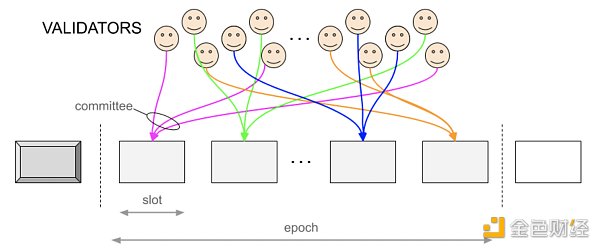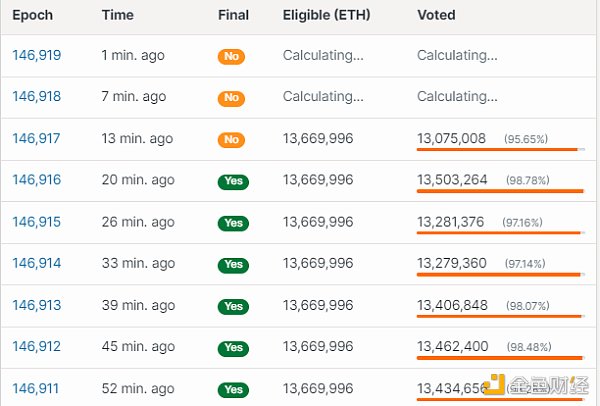At about 14:42 on September 15, Beijing time, Ethereum officially completed the merger. Ethereum triggered the merger mechanism at the block height of 15537393, and produced the first PoS block at the height of 15537394. Ethereum officially changed its consensus from PoW to PoS mechanism.
How much do you know about Ethereum 2.0 when Ethereum enters the post merger era? This article uses 15 concepts to guide you to understand it in depth.
1. Beacon chain
The beacon chain introduced proof of equity to Ethereum 1.0, which runs in parallel with Ethereum 1.0. The beacon chain is also called the coordination layer.
The beacon chain has the following functions:
Assign the responsibilities of the verifier
Confirm Checkpoints
Execute protocol level random number generator (RNG)
Facilitate beacon chain operation
Vote for fork chain head
2、Slots
32 Slot = 1 Epoch
1 The slot time is 12 seconds, and the randomly selected verifier proposes a block within this time. There may or may not be a block in each slot. All verifiers are divided into multiple committees, and one or more separate committees are responsible for verifying each slot. One verifier in the committee will be selected as the aggregator, while the other 127 verifiers will be verified. After each Epoch, the validators of each committee are mixed and merged into the new committee. Each committee has at least 128 validators.

3、Epoch
1 Epoch = 32 Slot
One Epoch indicates the number of 32 slots, which takes about 6.4 minutes.
Epoch plays an important role when it comes to the verifier queue and final certainty.
4. Deposit contract
The deposit contract reaches the gateway of Ethereum 2.0 through the smart contract on Ethereum 1.0.
The smart contract accepts any transaction with at least one ETH and valid input data.
Ethereum 2.0 beacon node monitors the deposit contract and uses the input data to trust each verifier node.
5. Input data
The input data, also known as deposit data, is a user generated 842 character sequence.
It represents the verifier's public key and withdrawal public key, and is signed by the verifier's private key. The input data needs to be added to the transaction and deposit contracts for identification by the beacon chain.
6. Validator
The verifier needs to deposit 32 ETHs in the verifier deposit contract on the Ethereum 1.0 chain. The authenticator operator must run a authenticator node. It is the responsibility of the verifier to propose the block and sign the certificate. The verifier must ensure at least half of the online time to obtain positive returns.
Eligible for activation&estimated activation
For details, refer to the following explanation of terms related to the verifier waiting to be activated. The margin deposit has been identified by the ETH2 chain "meets the activation conditions" timestamp. If there is a queue of verifiers waiting to be activated, the estimated activation timestamp needs to be calculated.
7. Unique Index
Each verifier receives its own unique index.

8. Current Balance&Effective Balance
The current balance represents the number of ETHs currently held by the verifier. The effective balance represents the value calculated from the current balance, which is used to determine the size of the reward or punishment received by the verifier. The effective balance must never exceed 32 ETH.
In order to increase the effective balance, the verifier requires "effective balance+1.25 ETH". In other words, if the effective balance is 20 ETH, the current balance of 21.25 ETH is required to obtain the effective balance of 21 Ethereum. As shown in the above example, the effective balance will be adjusted when it is lower than the threshold of 0.25.
The following is an example of how the effective balance changes:
If the current balance is 32.00 ETH - the effective balance is 32.00 ETH.
If the current balance decreases from 22.00 ETH to 21.76 ETH - the effective balance will be 22.00 ETH.
If the current balance increases to 22.25 ETH and the effective balance is 21 ETH, the effective balance increases to 22 ETH.
9. Whistleblower
Slasher is a self-contained entity, but requires a beacon node to receive the proof.
In order to detect malicious acts through the verifier, the flasher traverses all received proofs until it finds a confiscatory attack.
The found forfeiture is broadcast to the network, and the proposer of the next block will add the certificate to the block. Block proponents will be rewarded for confiscating malicious verifiers.
However, the whistleblower will not be rewarded.
A punishable crime
Attestation Violation
Double voting: The verifier signs two certificates of conflict in the same epoch.
Circumferential voting: The verifier circumferences another certificate to sign the certificate.
Proposer Violation
Dual block proposal: A block proposer signs two conflicting blocks for the same slot.
10. Attestation
Vote by the Attester who verifies the validity of the block.
11. Block Proposer
The verifier selected by the beacon chain proposes the next block. Each slot can only have one valid block.
12. Block Status
Proposed: The proposed block is verified by the verifier.
Scheduled: The verifier is submitting data.
Missed/Skipped: The proposer did not successfully propose a block within the given time, so the block was omitted.
Orphaned: To understand the term, let's look at the figure below, where the numbers 1-9 represent slots.
1. The verifier of slot1 proposes block "a".
2. The verifier of slot2 proposes block "b".
3. Slot4 was omitted because the verifier did not propose any blocks (such as offline).
4. There is a fork in slot 5/6: the verifier (5) proposed a block, but the verifier (6) did not receive relevant information (for example, the block did not reach the verifier fast enough). So the verifier (6) proposed a block based on the latest information seen from the verifier (3).
5. The fork selection rule plays a key role here - it determines which of the available chains is the normative chain.

13. Verifier lifecycle
(1) Deposit deposited
32 ETH has deposited into the ETH1 deposit contract, which will last for about 7 hours. This provides security when the ETH1 chain is attacked.
(2) Wait for activation
Wait for activation on ETH2.
Before the verifiers enter the verifier queue, they need to be voted in by other active verifiers. Vote every 4 hours.
Until there are 327680 active verifiers in the network, each epoch can activate 4 verifiers. Each additional 65536 (=4 * 16384) active verifiers will increase the verifier activation rate by 1 point.
Thereafter, each epoch can activate 5 verifiers, which requires 327680 active verifiers, that is, 1125 verifiers per day.
Each epoch activates 6 verifiers, which requires 393216 active verifiers, i.e. 1350 verifiers per day.
Each epoch activates 7 verifiers, which requires 458752 active verifiers, i.e. 1575 verifiers per day.
Each epoch activates 8 verifiers, which requires 524,288 active verifiers, that is, 1800 verifiers per day.
Each epoch activates 9 verifiers, which requires 589824 active verifiers, that is, 2025 verifiers per day.
Each epoch activates 10 verifiers, which requires 655360 active verifiers, that is, 2200 verifiers per day.
The number of activations increases with the number of active verifiers, which is limited to the set of active verifiers divided by 64.000.
(3) Active Validator
Blocks currently being confirmed and proposed (=block proposer)
The verifier will remain active until:
Its balance is less than 16 ETH (kicked out of the network)
Voluntary withdrawal
Be confiscated
(4) Slashing Validator
The verifier is a malicious verifier and will be confiscated and kicked out of the system.
Penalty is a negative reward (such as offline).
Slashing is a major punishment (≥ 1/32 pledge balance) and forced withdrawal.... -- Justin Drake
(5) Exiting Validator
Kick out of the network: The verifier's balance is lower than the threshold and is kicked out of the network.
Exit from the network: voluntarily exit, and the withdrawal key holder can withdraw the current balance of the corresponding verifier's balance.
14. Finalization
In Ethereum 2.0, at least two thirds of the verifiers must be honest. Therefore, if there are two epochs competing with each other, and one third of the verifiers decide to commit malicious acts, they will be punished. Honest people will be rewarded.
In order to determine whether an Epoch has been finally determined, the verifier must agree on the latest two consecutive Epochs (="proven"), and then all previous Epochs can be considered to have been finally determined.

15. Final issues
If the voting rate of an epoch is lower than 66.6% (=participation rate), the epoch cannot be established. As mentioned in the concept of "final determination", it requires three consecutive epoch that have been proven to reach the final determination. As long as the chain cannot reach this state, there will be a problem of final certainty.
During the period of final certainty, the verifier queue will be suspended, and new verifiers cannot join the network. However, inactive verifiers with a balance of less than 16 ETH will be kicked out of the network. This makes the network more stable and the participation rate higher.